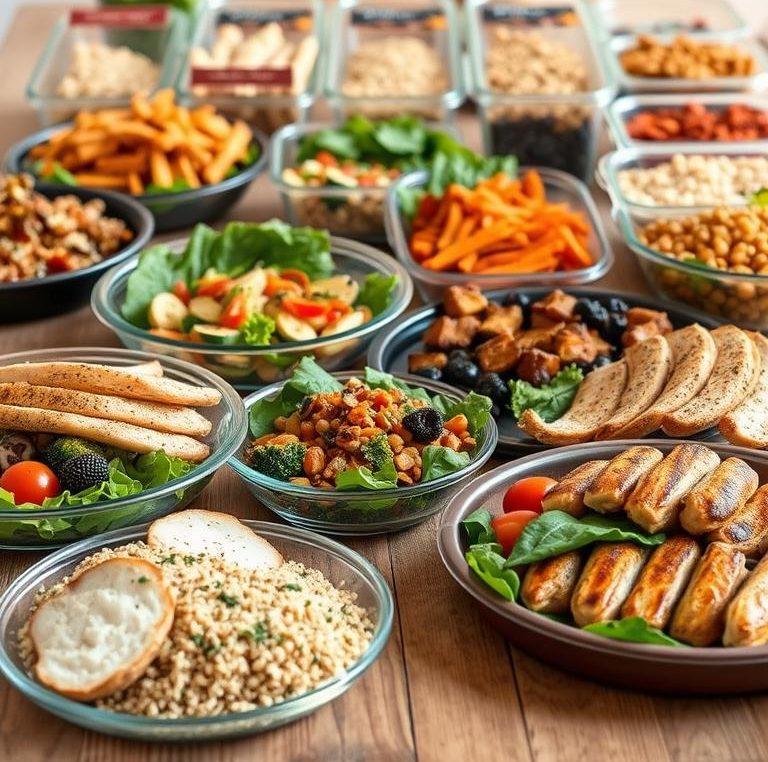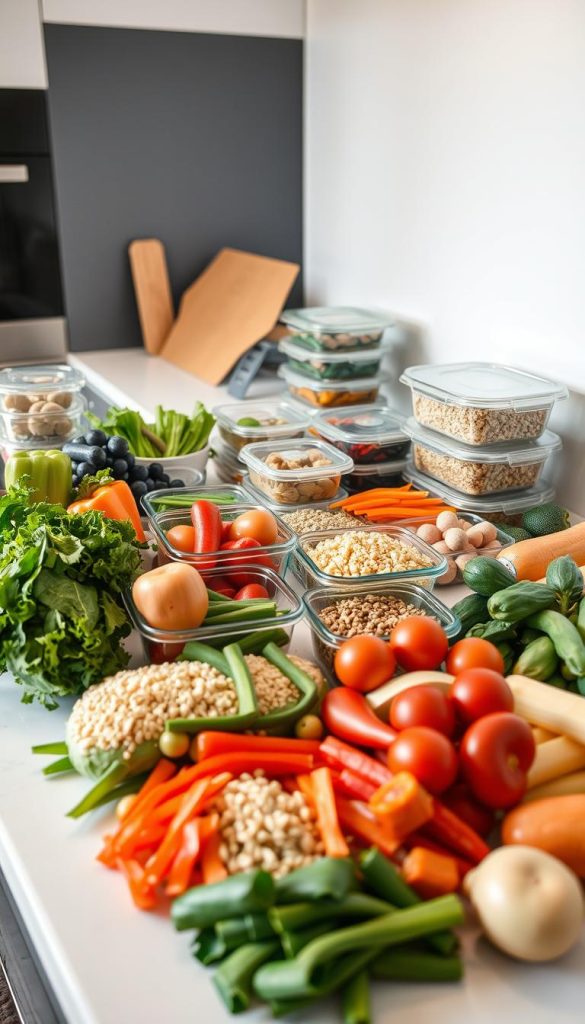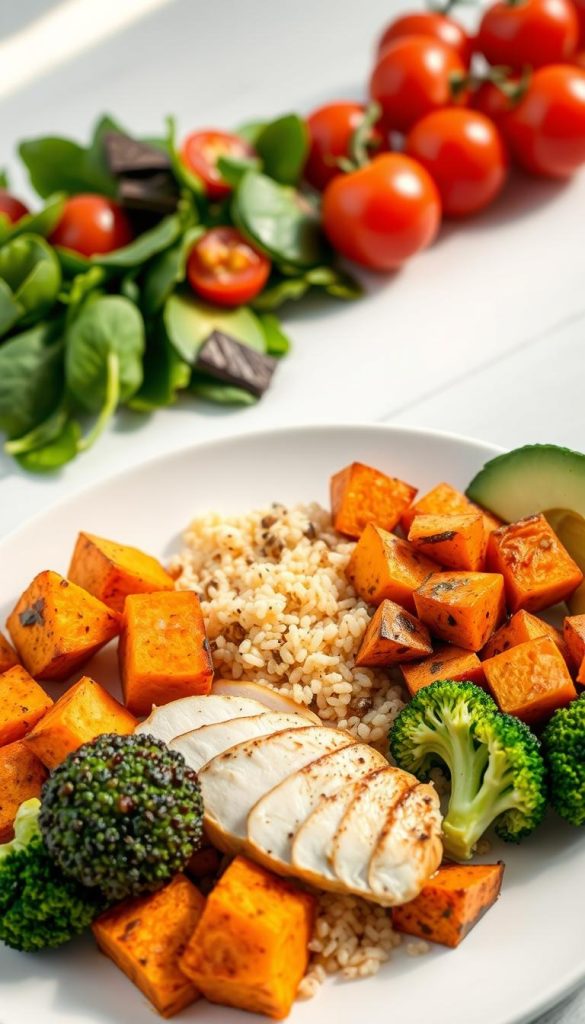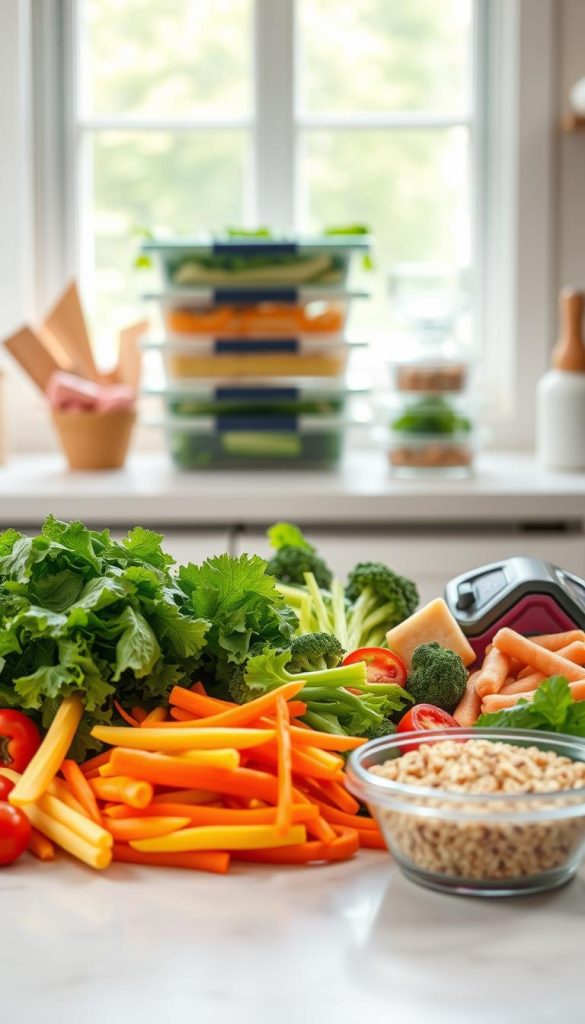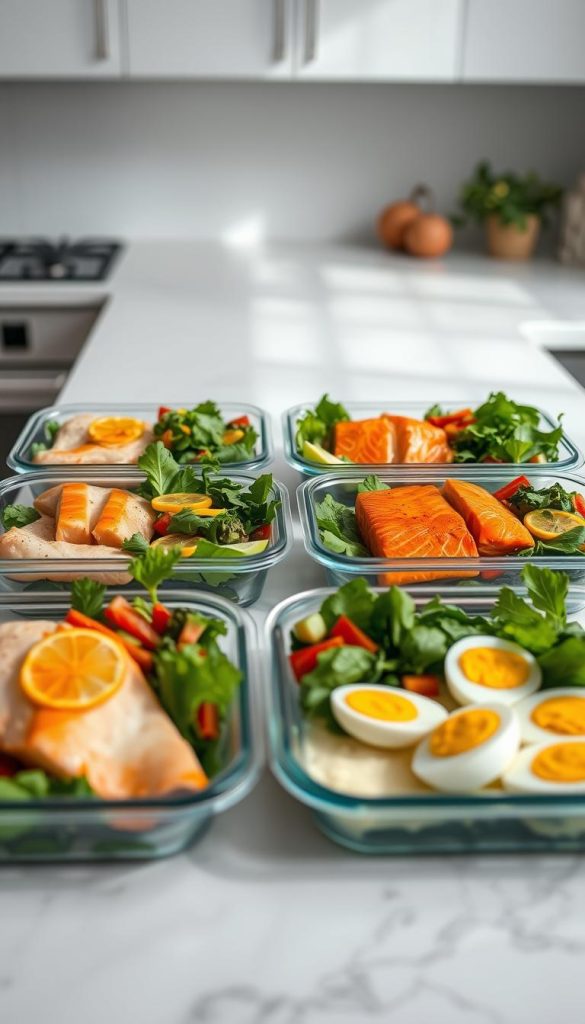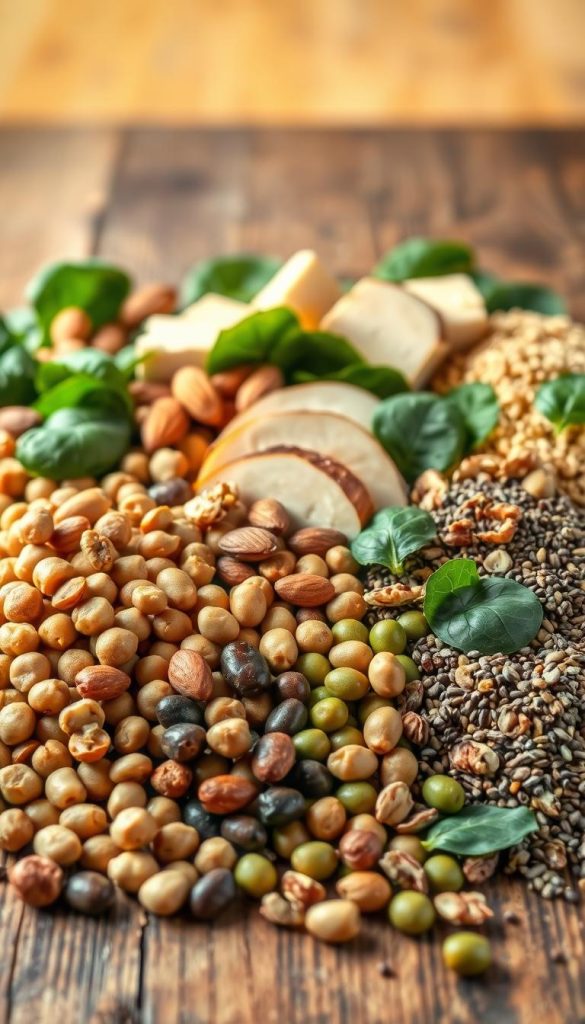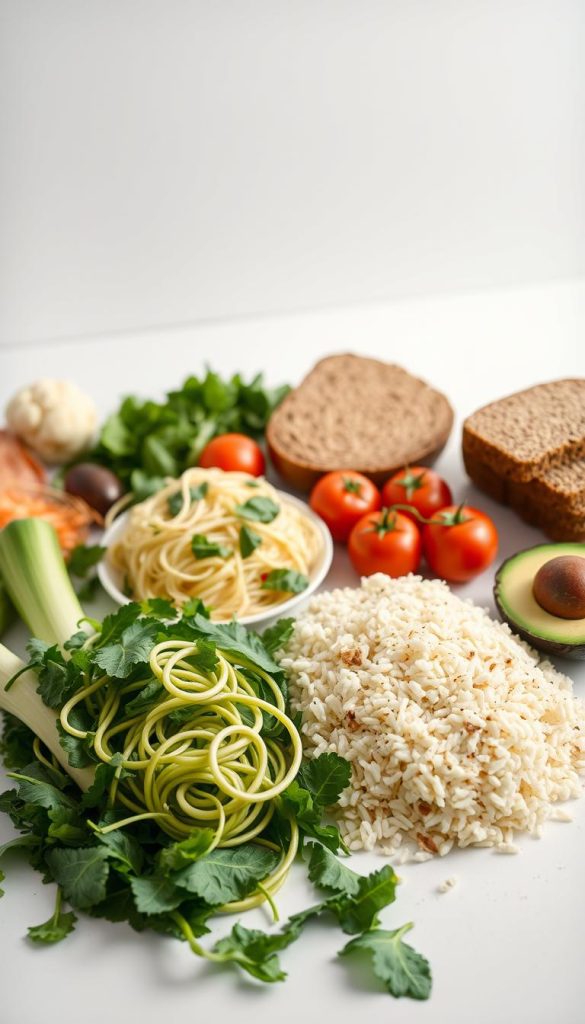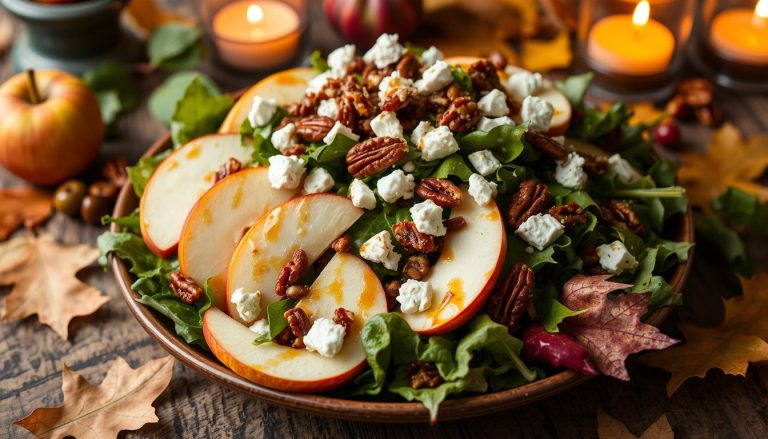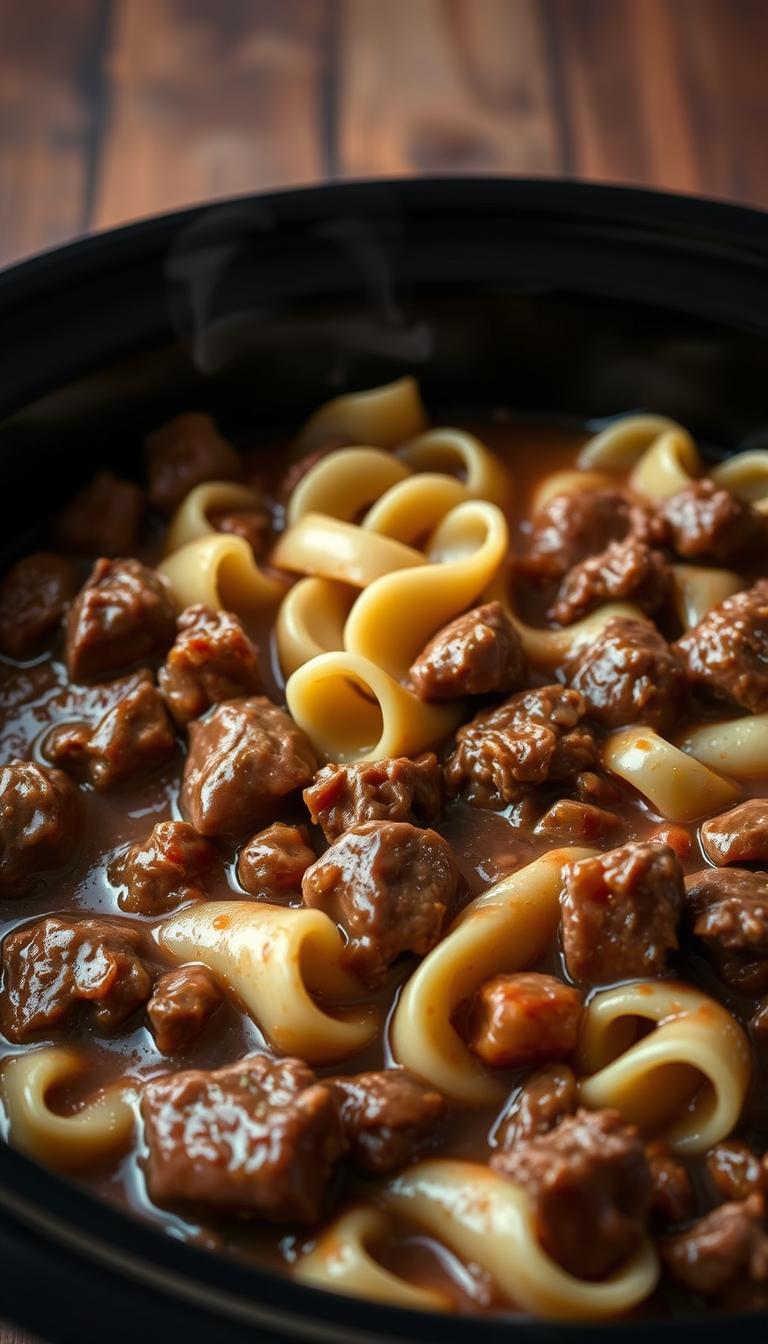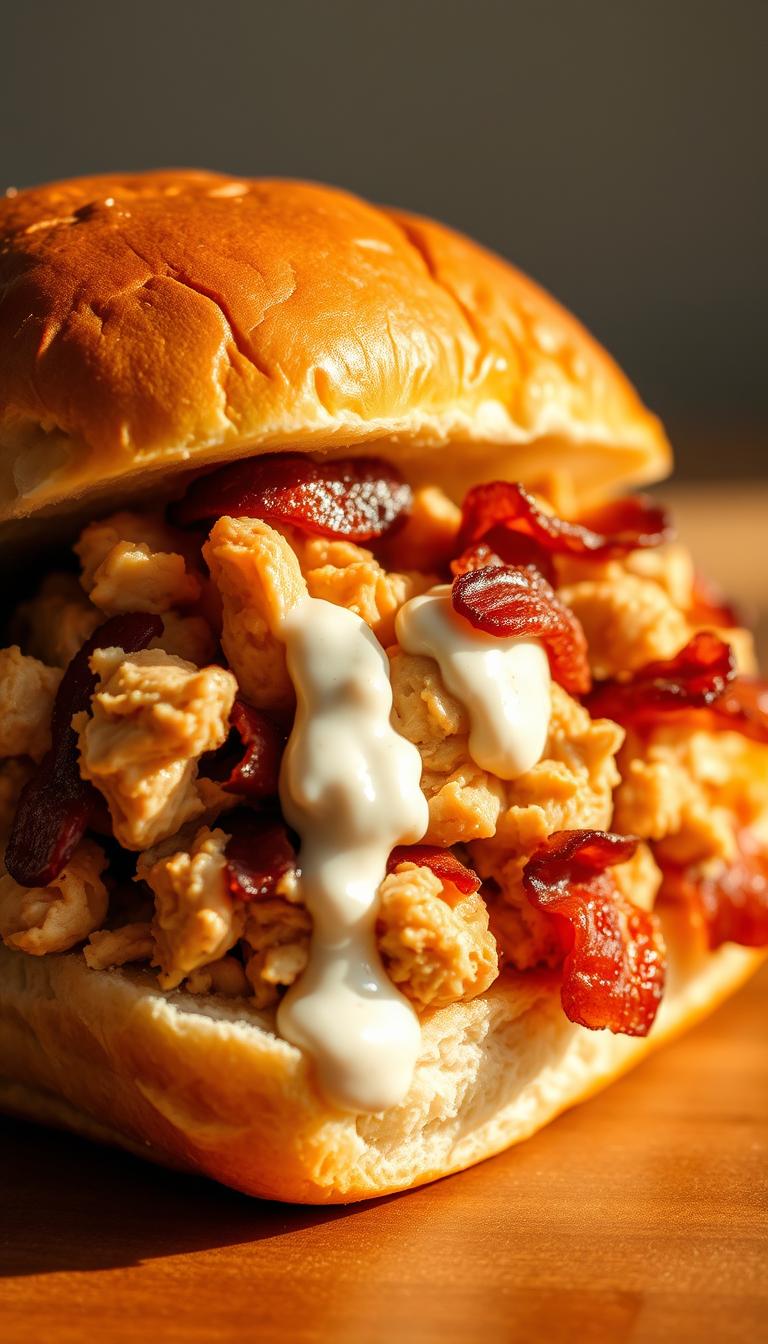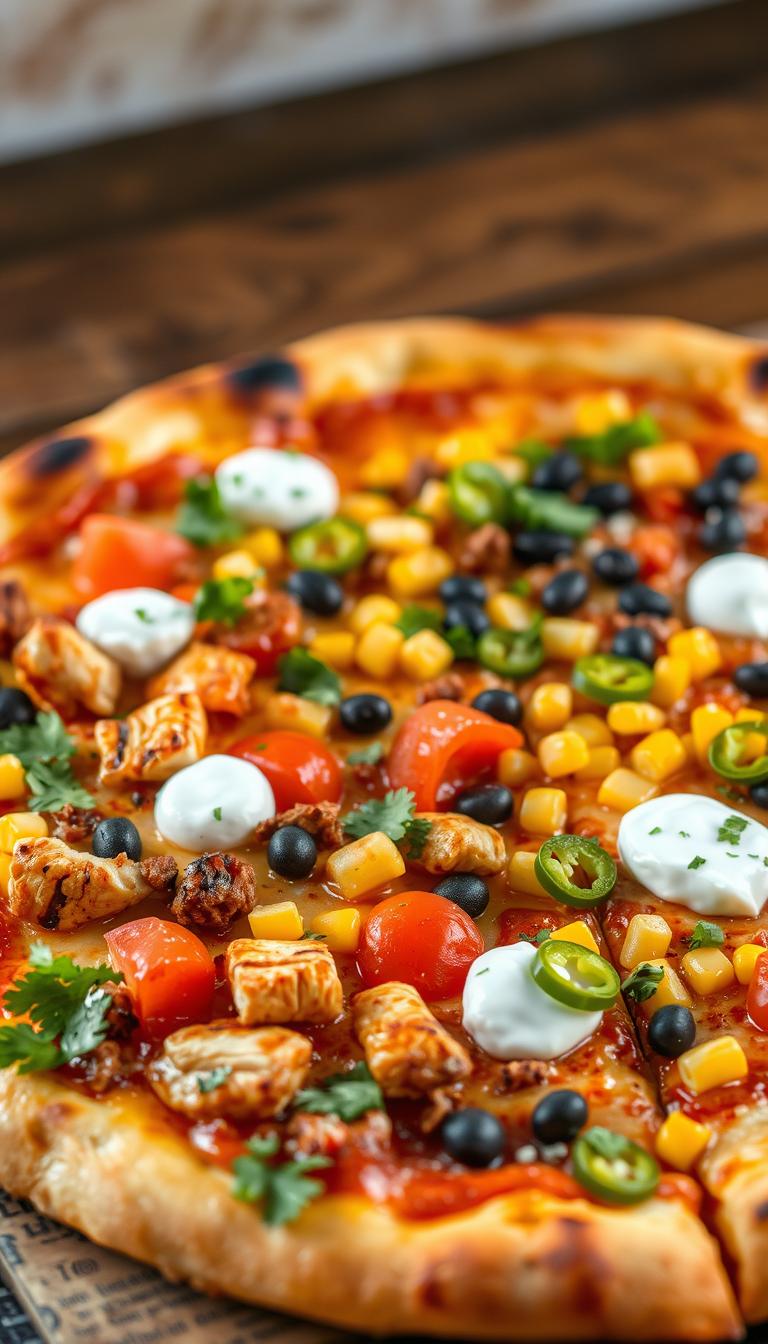30 High-Protein Meal-Prep Lunches to Help Manage Blood Sugar
Meal prepping is a powerful strategy for maintaining stable blood sugar levels. By preparing balanced, nutrient-dense lunches in advance, you can avoid the pitfalls of impromptu, unhealthy choices. High-protein ingredients, such as lean meats, legumes, and whole grains, are particularly effective at keeping you full and supporting overall health.
Each meal in this collection is designed to be diabetes-friendly, focusing on lower amounts of saturated fats, sodium, and carbohydrates. From hearty grain bowls loaded with chicken or salmon to vibrant salads packed with legumes, these recipes offer a variety of flavors and textures to keep your meals exciting and nutritious.
Throughout this article, you’ll discover quick tips for meal prepping, balanced recipes, and valuable nutritional insights to help you make informed choices. Whether you’re looking to improve your blood sugar management or simply want to eat healthier, these high-protein meal ideas will provide you with the tools you need to succeed.
Key Takeaways
- High-protein meals can help regulate blood sugar and keep you feeling full longer.
- Incorporate lean meats, legumes, and whole grains into your meal prep for balanced nutrition.
- Diabetes-friendly meals focus on reducing saturated fats, sodium, and carbohydrates.
- Meal prepping can simplify healthy eating and save time during the week.
- These recipes offer a variety of flavors and textures to keep your diet interesting.
Meal Prep Fundamentals for Managing Blood Sugar
Planning balanced meals is key to maintaining steady blood glucose levels. By organizing your meals in advance, you can avoid making unhealthy choices and ensure consistent nutrition throughout the day.
A well-structured meal prep plan begins with simple, balanced recipes that focus on lean proteins, whole grains, and vegetables. These ingredients not only help regulate blood sugar but also keep you satisfied longer. Storing meals in airtight containers can preserve freshness and make healthy eating more convenient.
Controlling fat intake is another crucial aspect. Opting for healthier fats, like avocado or olive oil, can enhance meal quality without overloading on calories. Additionally, adjusting portion sizes based on your daily calorie needs—whether it’s 1,500, 1,800, or 2,000 calories—ensures your meals remain balanced and nutritious.
Planning your meals for the entire day helps maintain nutritional balance. Incorporate a variety of recipes that align with your dietary goals, and don’t hesitate to modify ingredients to suit your preferences. By focusing on these fundamentals, you can create a meal prep routine that supports your health and keeps your energy levels steady throughout the day.
Why High-Protein Meals are Essential for Blood Sugar Control
Protein plays a vital role in stabilizing blood glucose levels, making it a cornerstone of diabetes-friendly diets. Each serving of high-protein meals slows digestion, preventing rapid spikes in blood sugar. This effect helps maintain steady energy levels throughout the day.
High-protein lunches, such as chicken salads or grain bowls, are particularly beneficial. Chicken, with its lean protein content, is an excellent choice for balancing blood sugar. A single serving of chicken provides about 15 grams of protein, which slows carbohydrate absorption and keeps you fuller longer.
| Meal Type | Protein Source | Protein Content (per serving) | Benefits |
|---|---|---|---|
| Chicken Salad | Chicken Breast | 25g | Slow digestion, sustained energy |
| Grain Bowl | Grilled Chicken | 20g | Stabilizes blood sugar, supports muscle repair |
| Chicken Stir-Fry | Chicken Thigh | 18g | Rich in lean protein, reduces cravings |
Portion control is crucial. Moderate servings ensure steady energy without overloading on calories. Lunch is a key meal for maintaining this balance, as it provides the necessary protein to sustain energy levels until dinner.
Building a Balanced Plate: Protein, Carbohydrates, and Fiber
Creating a balanced plate is essential for maintaining steady energy levels and supporting overall health. A well-rounded meal typically consists of lean proteins, high-fiber carbohydrates, and nutrient-dense vegetables. This combination helps regulate blood sugar and keeps you satisfied longer.
A balanced dinner plays a crucial role in your daily nutrition. It helps replenish energy stores after a busy day and prepares your body for the night ahead. By including a mix of proteins, carbohydrates, and fiber, you ensure that your meals are not only nutritious but also satisfying.
High-fiber foods, such as whole grains and vegetables, are particularly beneficial. They slow digestion, preventing rapid blood sugar spikes. This makes them an excellent choice for blood sugar control. Incorporating whole grains into your meals can also enhance the nutritional value of your food.
Timing your meals consistently can improve metabolic outcomes. Eating at regular intervals helps maintain stable energy levels and supports overall health. A well-timed dinner ensures that your body gets the nutrients it needs to function optimally throughout the night.
Practical examples of balanced plates include meals like grilled chicken with quinoa and steamed vegetables or salmon with brown rice and a side salad. These combinations provide a mix of lean proteins, high-fiber carbohydrates, and nutrient-dense vegetables, making them ideal for a healthy dinner.
Quick and Nutritious Meal Prep Tips
Streamlining your meal prep process can make healthy eating easier and more enjoyable. By incorporating simple strategies, you can save time while maintaining flavor and nutrition.
Time-saving Techniques
One of the most efficient ways to speed up your meal prep is by using pre-prepped ingredients. Prewashed greens and microwavable quinoa are excellent options that reduce active cooking time. Ready-made dressings can also simplify the process, allowing you to focus on assembling meals rather than preparing every component from scratch.
- Opt for prewashed greens to save on washing and chopping time.
- Use microwavable quinoa for a quick protein-packed base.
- Incorporate ready-made dressings to enhance flavor without extra effort.
Storing and Reheating Best Practices
Proper storage is key to maintaining the freshness and nutritional value of your meals. Use airtight containers to keep your prepped ingredients fresh for several days. When reheating, steaming or using a toaster oven helps preserve nutrients and texture. Adding a homemade or low-sugar sauce can elevate the flavor of your meals without adding excess calories.
- Store ingredients in airtight containers to maintain freshness.
- Reheat using steam or a toaster oven for optimal texture.
- Enhance meals with homemade or low-sugar sauces for added flavor.
By implementing these practical tips, you can create delicious, nutritious meals efficiently. Whether you’re a busy professional or someone looking to eat healthier, these strategies will make meal prep a breeze.
Incorporating Lean Proteins: Chicken, Salmon, and More
Lean proteins are a cornerstone of a balanced diet, offering numerous health benefits. They provide essential nutrients while keeping you full longer, which is especially beneficial for blood sugar control.
Chicken and salmon are excellent examples of lean proteins often used in meal prep. A 3-ounce serving of baked salmon offers about 17 grams of protein, while a similar portion of grilled chicken provides around 20 grams. These amounts help maintain muscle mass and support overall health.
| Protein Source | Grams of Protein per Serving | Benefits |
|---|---|---|
| Chicken Breast | 25g | Supports muscle repair and digestion |
| Salmon | 17g | Rich in omega-3 fatty acids for heart health |
| Turkey Breast | 24g | Low in saturated fat, high in nutrients |
Combining these proteins with vegetables like broccoli or spinach enhances your meal’s nutrient density. This approach ensures a well-rounded intake of vitamins and minerals. Additionally, choosing lean proteins over red meat can reduce saturated fat intake, supporting heart health and weight management.
Vegetables add fiber and vitamins, making your meals more satisfying and nutritious. This balanced approach helps maintain steady energy levels and supports long-term health goals.
Exploring Plant-Based Protein Options in Your Meal Prep
Plant-based proteins offer a nutritious and versatile way to enhance your meal prep. These options are not only rich in protein but also low in calories and high in fiber, making them ideal for balancing your diet.
Plant-based proteins, such as beans, tofu, and edamame, provide high-quality protein without the excess calories found in some meat-based dishes. For example, a serving of cooked lentils contains about 18 grams of protein and only 230 calories, making them a great choice for those looking tomanage their calorie intake.
When comparing plant-based meals to traditional meat-based ones, plant-based options often have lowercarbohydratecontent and higher fiber, which can help reduce blood sugar spikes. For instance, a meal prep recipe featuring chickpeas and quinoa offers a balanced mix of protein, fiber, and healthy carbs, keeping you full longer while maintaining steady energy levels.
Incorporating plant-based proteins into your meal prep can also help youstay within your daily calorie goals. For example, a lentil stir-fry or a chickpea salad can provide up to 20 grams of protein per serving, all while keeping calorie counts in check. These meals are not only nutritious but also delicious and easy to prepare, making them a great addition to your meal prep routine.
By choosing plant-based proteins, you can enjoy the benefits of high-protein meals without the need for animal products. This approach supports a balanced diet and helps you maintain your health goals with ease.
30 High-Protein Meal-Prep Lunches to Help Manage Blood Sugar
Discover a variety of delicious and nutritious meal-prep ideas designed to keep your blood sugar in check. Each recipe is crafted with specific protein per serving in mind, ensuring you stay full and energized throughout the day.
From hearty grain bowls to fresh salads, these meals incorporate ingredients like lean proteins, whole grains, and vibrant vegetables. A kale salad with grilled chicken offers about 25 grams of protein per serving, while a quinoa bowl with salmon provides around 20 grams. These options not only stabilize blood sugar but also offer sustained energy.
Each dish is easy to prepare and optimized for blood sugar control. For instance, a Greek-inspired salad with chickpeas and feta cheese delivers approximately 18 grams of protein per serving. Such meals are perfect for meal prep, as they are simple to assemble and pack.
Incorporating these high-protein lunches into your routine can make a significant difference in managing blood sugar levels. With a focus on fresh ingredients and balanced nutrition, these recipes provide a tasty and healthy solution for your meal-prep needs.
Vibrant Salads and Grain Bowls for Sustained Energy
Vibrant salads and grain bowls are a great way to keep your energy levels steady throughout the day. These dishes combine lean proteins, high-fiber ingredients, and a variety of colorful vegetables, making them both nutritious and visually appealing.
Customizing Your Salad Base
Start with a base of mixed greens or kale for a nutrient-packed foundation. Add whole grains like quinoa or brown rice to boost fiber content and keep you full longer. For extra protein, include grilled chicken or salmon, which provide sustained energy without causing sugar spikes.
- Choose mixed greens or kale for a nutrient-dense base.
- Add whole grains like quinoa or brown rice.
- Incorporate grilled chicken or salmon for a protein boost.
Incorporating Whole Grains
Whole grains like quinoa and farro are rich in fiber, which helps slow digestion and minimize sugar spikes. Pair them with lean proteins such as chicken or tofu for a balanced meal that keeps you energized all day.
- Use quinoa or farro for added fiber.
- Pair with lean proteins like chicken or tofu.
Benefits of Fresh Vegetables
Fresh vegetables add natural sweetness and crunch to your salads and grain bowls. They are also packed with vitamins and antioxidants that support overall health and balanced blood sugar levels. Include a variety of colors to ensure a wide range of nutrients.
- Add fresh vegetables for natural sweetness and texture.
- Incorporate a variety of colors for diverse nutrients.
Examples like the Sweet Potato, Kale & Chicken Salad and Salmon & Quinoa Bowls showcase how these ingredients come together. The Sweet Potato, Kale & Chicken Salad offers a balance of protein and fiber, while the Salmon & Quinoa Bowl provides omega-3 fatty acids and sustained energy. These recipes are not only delicious but also designed to support your health goals with minimal effort.
Smart Ingredient Swaps for Lowering Calories and Carbohydrates
Making smart ingredient swaps can transform your meals, reducing calories and carbs without sacrificing flavor. These swaps are simple yet effective, helping you maintain balanced nutrition and support blood sugar control.
One effective strategy is reducing sodium and carbohydrate-rich components. For instance, choosing low-sodium alternatives for soups or sauces can significantly lower overall sodium intake. Additionally, substituting refined pasta with bean-based options, like black bean pasta, not only cuts carbs but also boosts fiber and protein content.
Quick swaps can make a big difference in just a minute. Replacing traditional pasta with zucchini noodles or using cauliflower rice instead of regular rice are easy, time-saving changes. These substitutions can be implemented in everyday recipes, enhancing nutritional value without extra effort.
| Ingredient | Traditional | Alternative | Calorie Reduction |
|---|---|---|---|
| Pasta | 150g (250 calories) | Black Bean Pasta (150g) | 180 calories |
| Rice | 150g (210 calories) | Cauliflower Rice (150g) | 120 calories |
| Bread | 1 Slice (120 calories) | Low-Carb Alternative | 80 calories |
For example, using black bean pasta instead of traditional pasta reduces calories from 250 to 180 per 150g serving. Similarly, cauliflower rice cuts calories from 210 to 120 per 150g serving. These smart swaps make meals healthier and more balanced, supporting overall health goals without compromising taste.
Flavorful Sauces and Dressings to Elevate Your Meals
Flavorful sauces and dressings can elevate your meals from ordinary to extraordinary, adding a burst of taste that keeps your palate engaged. These condiments are more than just toppings; they are the key to transforming a simple dish into a memorable one.
Creating your own sauces and dressings allows you to control sodium and sugar content, ensuring they complement your high-protein ingredients without compromising nutritional balance. For instance, a homemade peanut dressing or a green goddess dressing can add depth to your meals while keeping them healthy.
Cheese can be a wonderful addition, offering creaminess without overwhelming calories. Used in moderation, it enhances flavors and textures, making your meals more satisfying. Consider a light sprinkle of feta or a dollop of ricotta to add richness.
Planning ahead is essential for a seamless week of meals. Preparing sauces and dressings in advance ensures they are ready when you need them, making meal assembly quick and effortless. Store them in airtight containers to maintain freshness throughout the week.
Practical examples include making a batch of vinaigrette or a yogurt-based sauce. These can be used in various dishes, from salads to grain bowls, providing consistent flavor without repetition. This approach keeps your meals exciting and your prep time minimal.
Easy Sheet-Pan and One-Pot Meal Ideas
Sheet-pan and one-pot meals are perfect for busy weeknights, offering convenience and minimal cleanup. These recipes simplify cooking, reducing dishwashing and active cooking time. They are ideal for those seeking efficiency without compromising on nutrition or flavor.
Shrimp is a great protein for these meals due to its quick cooking time. A shrimp and vegetable sheet-pan dinner can be prepared in under 30 minutes, with shrimp providing about 19 grams of protein per serving. Pairing shrimp with whole grains like quinoa or brown rice enhances the meal’s nutritional balance, ensuring sustained energy levels.
Cooking proteins and vegetables evenly in one pot can be achieved by layering ingredients. For example, placing shrimp on top of vegetables allows both to cook uniformly. This method ensures a balanced and flavorful dish without extra effort.
- Layer ingredients to ensure even cooking.
- Start with proteins like shrimp, then add vegetables and grains.
- Season with herbs and spices for added flavor without extra calories.
Sheet-pan salmon with tomatoes is another efficient option, requiring only one pan and including a side dish. This recipe not only simplifies cleanup but also provides a well-rounded meal with lean protein and vitamins from the tomatoes.
Maximizing Meal Prep Efficiency with Batch Cooking
Batch cooking is a game-changer for streamlining your meal prep routine. By preparing large batches of ingredients, you can significantly reduce the time spent on daily meal preparation while maintaining nutritional balance.
Planning Ahead for the Week
A well-structured plan is essential for efficient batch cooking. Start by mapping out your meals for the entire week, considering your dietary goals and ingredient availability. This approach ensures consistency and reduces food waste.
- Plan meals around nutrient-dense ingredients like salmon, which offers about 17 grams of protein per serving.
- Measure nutrient values to ensure each meal meets your health objectives.
- Incorporate salmon for its high protein content and ease of batch cooking.
Organizing your cooking schedule is key to maximizing efficiency. Dedicate one or two days to batch cooking, focusing on proteins, grains, and vegetables. This method allows you to assemble meals quickly throughout the week.
For example, bake several salmon fillets and portion them into individual servings. Pair with pre-cooked quinoa and steamed vegetables for a balanced meal. This strategy ensures each serving provides approximately 20 grams of protein and a mix of essential nutrients.
By implementing these batch cooking strategies, you can enjoy nutritious, time-saving meals that support your health goals without sacrificing flavor or variety.
Understanding Nutritional Labels and Serving Sizes
Reading nutritional labels is crucial for effective meal prep, especially when managing blood sugar levels. These labels provide essential data like calories, fat, and sodium, helping you make informed choices. For instance, a power salad with 26 grams of protein and 8 grams of fiber per serving can help stabilize blood sugar, while a Southwestern-style pasta salad offers 14 grams of fiber using black bean pasta, which is lower in carbs.
Understanding serving sizes is key to controlling portions and managing blood sugar. Accurate serving sizes ensure you consume the right amount of nutrients without overeating. For example, a 3-ounce serving of chicken provides about 24 grams of protein, which helps regulate blood sugar. Proper portion control maintains balanced nutrition and steady energy levels.
Identifying misleading label information is important. Terms like “low-fat” might mean high sugar, and “whole grain” doesn’t always imply high fiber. Always check the ingredient list and nutrition facts to avoid hidden sugars and unhealthy fats that could affect your health goals.
Accurate prep techniques can enhance the nutritional value of your meals. Portioning ingredients correctly and using the right components as per labels ensures each meal is balanced. For example, using low-sodium ingredients or choosing products with minimal added sugars helps maintain nutritional integrity.
By understanding and applying this knowledge, you can create meals that support your health objectives, making meal prep a valuable tool for maintaining balanced nutrition and managing blood sugar levels effectively.
Adjusting Your Meal Prep for Different Calorie Requirements
Customizing your meal prep to fit specific calorie needs is essential for maintaining a balanced diet. Whether you’re aiming for 1,500, 1,800, or 2,000 calories per day, small adjustments can make a big difference without sacrificing nutrition or flavor.
Understanding Calorie Modifications
Adjusting portion sizes is a simple way to tailor meals to your calorie goals. For example, reducing the serving size of rice from 1/2 cup to 1/3 cup can save about 50 calories. This subtle change helps maintain a balanced bowl without overloading on carbs.
- Swap white rice for cauliflower rice to cut calories further.
- Adjust protein portions based on your activity level.
- Add extra vegetables to keep meals filling and nutritious.
Maintaining a consistent bowl of ingredients helps regulate blood sugar levels. Focus on lean proteins, whole grains, and a variety of vegetables to ensure each meal is balanced and satisfying.
For instance, a 1,500-calorie meal might include a smaller portion of grilled chicken and more steamed vegetables. A 2,000-calorie meal could add a side of quinoa or brown rice for extra energy. These tweaks ensure your meals stay balanced and aligned with your goals.
Integrating High-Protein Meals Into Your Daily Routine
Incorporating high-protein meals into your daily routine can be simple and delicious. Whether you’re preparing for a busy week or just want to eat healthier, these meals offer a convenient solution. Flavor plays a key role in keeping your diet exciting, so don’t be afraid to experiment with different seasonings and ingredients.
One practical way to integrate high-protein meals is by preparing them ahead of time. For example, a turkey and quinoa bowl can be meal-prepped in just a few minutes and reheated when you’re ready. This approach ensures you have a nutritious meal ready in under a minute, perfect for those with tight schedules.
| Meal | Protein Source | Prep Time | Benefits |
|---|---|---|---|
| Turkey Bowl | Turkey Breast | 10 Minutes | High in protein, low in carbs |
| Chicken Salad | Chicken Breast | 5 Minutes | Quick assembly, sustained energy |
| Salmon Bowl | Salmon | 8 Minutes | Rich in omega-3s, easy prep |
Using a variety of proteins like turkey and chicken keeps your meals interesting and ensures you’re getting all the nutrients you need. Planning your meals for the week can help you stay on track and avoid unhealthy choices. Experiment with different recipes to find what works best for your lifestyle and taste preferences.
Conclusion
Meal prepping is a practical approach to maintaining balanced nutrition and supporting overall health. By focusing on nutrient-dense ingredients like lean proteins, fresh vegetables, and healthy fats, you can create meals that not only taste great but also provide sustained energy and support blood sugar control.
One of the key benefits of meal prepping is how quickly meals can come together, even on busy days. For example, a simple salad with grilled chicken or a quinoa bowl with roasted vegetables can be prepared in just a few minutes. These meals are not only quick but also packed with nutrients to keep you energized throughout the day.
Experimenting with recipes that feature yogurt-based dressings or other nutrient-rich ingredients can add variety to your meal prep routine. Whether you’re using Greek yogurt for a creamy sauce or incorporating it into a refreshing salad, it’s a great way to enhance flavor without adding excess calories.
Starting your meal prep journey doesn’t have to be overwhelming. Begin with simple, balanced recipes and gradually explore new flavors and ingredients. By incorporating these strategies into your daily routine, you can enjoy healthier, more delicious meals that support your overall well-being.

